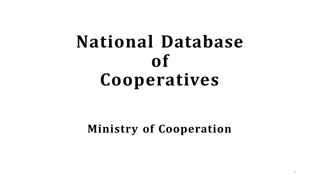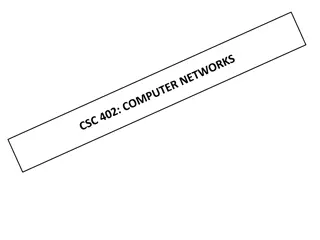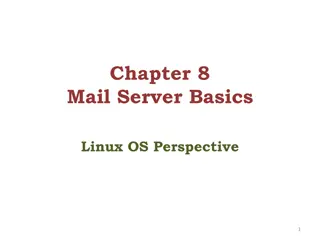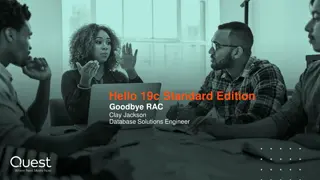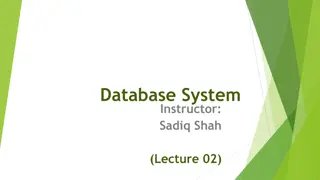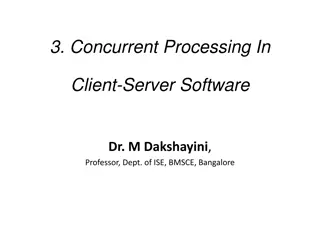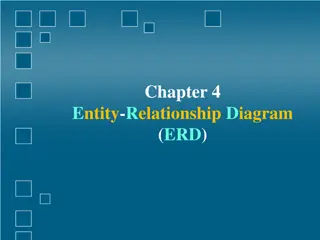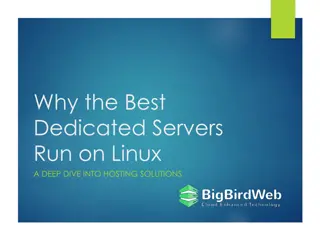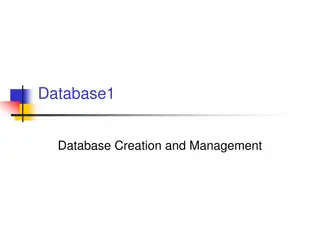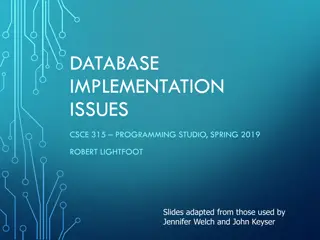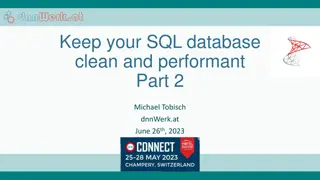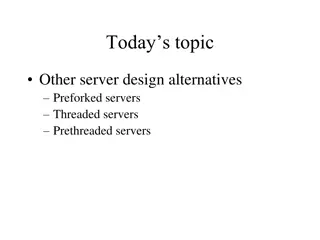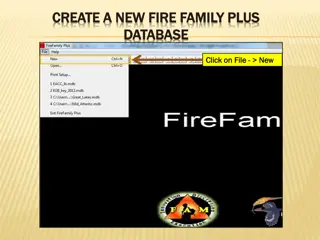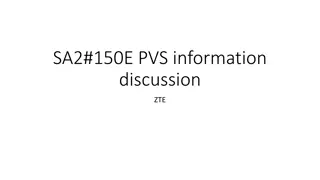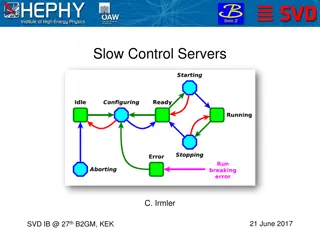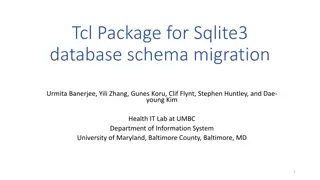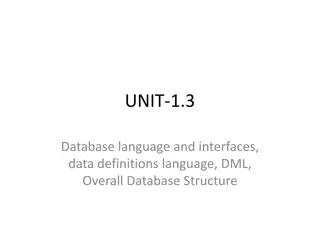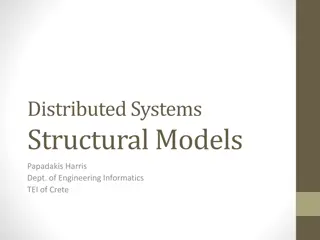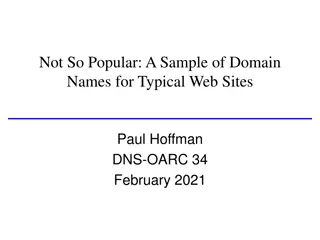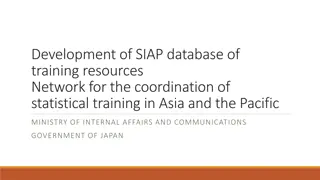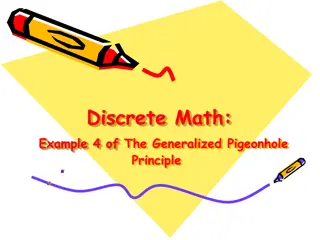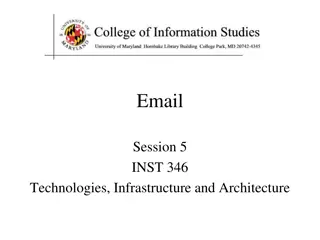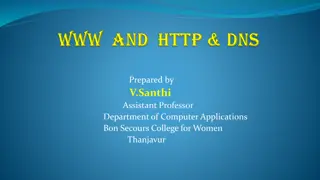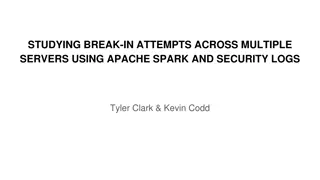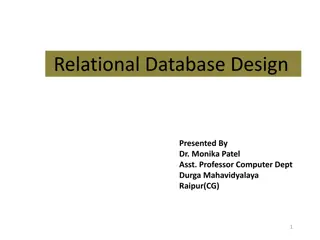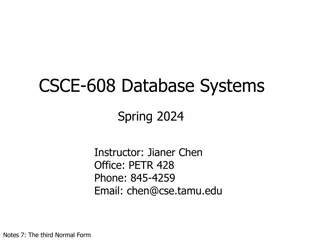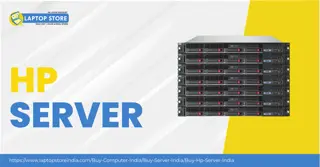National Database of Cooperatives: Ministry of Cooperation Initiatives
The Ministry of Cooperation is developing a National Database of Cooperatives to enhance transparency, governance, and policymaking in the cooperative sector. The database aims to provide comprehensive information on cooperatives across sectors, improve coordination among stakeholders, and facilitat
0 views • 22 slides
Database Design Principles and Management Overview
This document presents an overview of database design principles, including structured, semi-structured, and unstructured data types. It delves into the role of Database Management Systems (DBMS) in defining, constructing, manipulating, and sharing databases effectively. It also covers various types
0 views • 47 slides
Introduction to Database Management System Explained
This presentation covers the basics of database management systems, including definitions of data, types of data, structured and unstructured data, storing data in computers using file systems and database systems, and issues with file systems like data redundancy, inconsistency, difficult data acce
3 views • 18 slides
Computer Networks and Servers
Computer networks are groups of connected computers that allow communication and resource sharing. They utilize network media, adapters, operating systems, and protocols. Servers are specialized network computers that provide centralized access to resources like applications, files, and email servic
1 views • 53 slides
Mail Server Basics from a Linux Operating System Perspective
Dive into the essentials of mail servers, exploring the key components of an email system, such as email clients and servers. Learn how email clients work, the functions they offer, and the role of email servers in managing and routing messages to ensure delivery over the Internet.
0 views • 25 slides
Oracle 19c Standard Edition: RAC Migration and Database Solutions Overview
Explore the implications of Oracle Database 19c Standard Edition no longer supporting RAC, and learn about disaster recovery and high availability options for users. Delve into the differences between HA and DR, along with the significance of workload isolation and scalability in database management
4 views • 22 slides
Costs and Risks of Implementing a Database Approach
Implementing a database approach involves additional costs and risks that need to be managed effectively. From hiring specialized personnel to dealing with conversion costs and organizational conflicts, organizations must carefully consider the implications of transitioning to a database system. The
2 views • 10 slides
Database Design Process and Concepts
This lecture on designing databases covers the database design process, normalization, transforming E-R diagrams, physical database design concepts, and steps in logical database modeling. It highlights the importance of logical and physical database design in system development, providing insights
1 views • 64 slides
Post-COVID-19 Operational Guide for PCR Inc.
The operational guide outlines safety protocols for PCR Inc. post-COVID-19, emphasizing a 50% capacity limit, presence of a certified food manager on-site, adherence to social distancing guidelines, frequent sanitation of high-touch surfaces, and mandatory mask-wearing. Employees are required to wea
2 views • 7 slides
Concurrent Processing in Client-Server Software
Concurrency in client-server software allows for simultaneous computing, involving multi-user systems, time-sharing, and multiprocessing. This concept is vital in distributed computing, occurring among clients and servers, as well as within networks. Developers design client programs without conside
4 views • 26 slides
Entity-Relationship Diagrams (ERD) for Database Design
Entity-Relationship Diagrams (ERD) are vital in database design, illustrating entities and their relationships. They help in conceptualizing data models and laying the groundwork for database structures. The process involves identifying entities, defining relationships, and analyzing interactions to
1 views • 40 slides
Database Security Measures and Controls
Database security is crucial to protect against threats like loss of integrity, availability, and confidentiality. Countermeasures such as access control, inference control, flow control, and encryption are important for safeguarding databases. Access control involves creating user accounts and pass
1 views • 35 slides
Performers and Programs Database Webinar - Overview and Features
Learn about the Performers and Programs Database Webinar happening on October 22, 2021. This webinar, presented by Peter Kowalski and introduced by Sharon B. Phillips, offers valuable information about the database's features, including how performers advertise programs, categorization, virtual prog
1 views • 25 slides
Introduction to Database Systems and SQL Programming
Understanding database systems is crucial in today's digital world. Explore the basics of database systems, SQL statements, and Java Database Connectivity (JDBC) in this comprehensive overview. Learn about DBMS, SQL querying, JDBC API, and more to enhance your understanding of managing and interacti
10 views • 24 slides
Overview of Database Systems Architecture and Languages
A database system is essential for storing and managing an organization's data. The architecture includes components like file manager, database manager, and query processor. Additionally, DML and DDL compilers play crucial roles in handling data manipulation and definition tasks. Various data struc
2 views • 28 slides
Why the Best Dedicated Servers Run on Linux
In the realm of web hosting, dedicated servers stand as the pinnacle of performance, control, and reliability. When it comes to choosing an operating system for these servers, Linux consistently emerges as the top choice for businesses, developers, a
1 views • 11 slides
Database Management Systems and Concepts
Explore the world of databases with topics ranging from Database Creation and Management to Basic Database Terms. Learn about the significance of data, information, and metadata in decision-making processes. Discover the purpose of database systems and the role of Database Management Systems (DBMS)
2 views • 25 slides
Database Implementation Issues in Programming Studio
Key topics covered in the slides include database implementation issues, storing data efficiently, and strategies for handling variable length fields in tuple storage. The presentation delves into specialized algorithms for database efficiency and reliability, terminology related to database impleme
0 views • 32 slides
Efficient SQL Database Maintenance for Performance
Learn to effectively clean and optimize your SQL database for optimal performance. Discover tools like Ola Hallengren's Maintenance Solution and Brent Ozar's First Responder Kit, along with best practices for backup, restore, index optimization, and database integrity checks. Ensure a healthy databa
0 views • 17 slides
Server Design Alternatives - A Comprehensive Overview
Exploring various server design alternatives such as preforked servers, threaded servers, prethreaded servers, sequential servers, and multiplexed servers. Discussing their implementations, efficiency, limitations, and potential combinations for optimal performance.
1 views • 12 slides
Guide to Importing and Organizing Station Catalogs and Weather Data
This guide provides step-by-step instructions on how to create a new database for fire-related data, name the database, save it in a specific folder, open the database, and import station catalogs and weather data. The process involves creating a fire family plus database, naming and saving it prope
0 views • 18 slides
Discussion on Provisioning Servers Addressing Information in 3GPP TS 23.501
Background CT4 LS in S2-2200200 issue 2 discussed the interpretation and intention of the addressing information for Provisioning Servers (PVS) as stated in 3GPP TS 23.501. The focus was on whether the provided PVS IP addresses and/or FQDNs are for a single PVS server or multiple servers and how the
0 views • 4 slides
Fault-tolerant and Load-balanced VuFind Project Overview
Project Background: Part of the National Digital Library initiative, the VuFind project aims to provide a discovery interface for Finnish archives, libraries, and museums. It started development in 2012 due to the insufficiency of existing commercial products. The focus is on enhancing fault toleran
1 views • 19 slides
Slow Control Servers and Network Configuration for SVD Management
The documentation discusses the setup and requirements for slow control servers, network configuration, FADC server status, ENV server status, and general SC server status for SVD management. It outlines the need for backup servers, minimum server requirements, server specifications, procurement det
0 views • 11 slides
The World of Azure Database Offerings
Exploring Azure's database offerings including Azure Cosmos DB and Azure SQL Database. Azure Cosmos DB provides a globally scalable document database solution, while Azure SQL Database is a great option for SQL Server workloads. Both platforms offer unique features such as low latency, scalability,
1 views • 15 slides
Tcl Package for SQLite3 Database Schema Migration
A Tcl package was developed to support schema migration in SQLite3 databases, enabling incremental or reversal changes to relational database schemas. The package includes functions for fundamental database operations like table creation, deletion, column addition, removal, and table renaming. By ge
0 views • 15 slides
Database Language and Interfaces Overview
A database management system (DBMS) requires appropriate languages and interfaces to handle queries and updates for data manipulation and control. This includes Data Definition Language (DDL), Data Manipulation Language (DML), Data Control Language (DCL), and Transaction Control Language (TCL). Each
1 views • 12 slides
Client-Server Paradigm in Distributed Systems
Client-server paradigm in distributed systems involves structuring systems as collaborating processes where clients request services from servers. The model follows a request/reply protocol, with servers providing centralized control of shared resources. Advantages include security and simplicity, w
1 views • 30 slides
Domain Names for Authoritative DNS Servers
Researchers need to accurately define the types of authoritative DNS servers they sample when measuring server properties. This study focuses on collecting domain names used for web servers to assess typical domain name characteristics, highlighting the importance of accurate data for research purpo
0 views • 7 slides
Development of Statistical Training Resource Database for Asia-Pacific by SIAP
Development of the SIAP database aims to coordinate statistical training resources in Asia and the Pacific. The database includes information on training courses, experts, materials, and schedules, facilitating data input and sharing for organizations and institutions. The database launch schedule a
0 views • 5 slides
Client-Server Computing in Distributed Systems
Client-server interaction forms the foundation of distributed computing, where clients rely on servers to perform operations. Clients can be various applications like browsers, email clients, and office software, while servers manage network resources and serve specific functions such as file storag
0 views • 17 slides
Minimum Direct Connections to Achieve Simultaneous Access
In a computer science laboratory with 15 workstations and 10 servers, the minimum number of direct connections needed to ensure that any set of 10 or fewer workstations can simultaneously access different servers is determined using the Generalized Pigeonhole Principle. By strategically connecting w
0 views • 5 slides
Email Technologies and Infrastructure
Explore the intricacies of email technologies, infrastructure, and architecture, including the format of HTTP messages, the role of proxy servers, creating web servers, and key components of email systems like user agents, mail servers, and SMTP protocol. Delve into email protocols like SMTP, POP3,
0 views • 38 slides
Client/Server Computing Architecture
Client/Server Computing architecture separates clients and servers over a network, allowing for file sharing, resource allocation, and service requests. Clients initiate services from servers, with transparent server locations and message-passing transactions. Systems with C/S architecture include f
0 views • 18 slides
Bonrix SMPP Gateway 1.0.1 Overview
Bonrix SMPP Gateway 1.0.1 is a J2EE web application that allows clients to connect via TCP-IP or HTTP API. It provides an administrative web interface for managing users, SMS termination settings, and offers various SMS termination mechanisms. The system uses MySQL and MongoDB as database servers an
0 views • 24 slides
The Architecture of the World Wide Web
The World Wide Web (WWW) is a vast repository of information accessible through a distributed client-server system. Users interact with web pages hosted on servers through browsers, utilizing URLs to navigate between different sites. This system consists of clients (browsers) and servers, where clie
0 views • 44 slides
Analyzing Break-In Attempts Across Multiple Servers using Apache Spark
Exploring cyber attacks on West Chester University's servers by analyzing security logs from five online servers using Apache Spark for large-scale data analysis. Uncovering attack types, frequency patterns, and sources to enhance security measures. Discover insights on break-in attempts and potenti
0 views • 19 slides
Relational Database Design Fundamentals
This content delves into the crucial aspects of relational database design, including normalization, pitfalls, RDBMS design issues, and the overall database design process. It emphasizes the need for well-structured relation schemas to minimize redundancy, ensure data integrity, and facilitate effic
1 views • 53 slides
Database Normalization and BCNF in Database Systems
Learn about the process of database development, including E-R diagrams, converting to relations, developing database operations, normalization, and BCNF. Explore algorithms for achieving BCNF and example scenarios to understand key concepts in database systems.
0 views • 43 slides
Top HP Servers in India - Shop Now at LaptopStoreIndia
Invest in quality with HP servers available at LaptopStoreIndia. Enhance your business operations with the best servers in the market. Buy now: Buy HP Server India.
1 views • 5 slides
